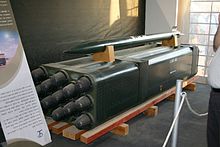LAR-160

The LAR-160 is an Israeli multiple missile launcher system .
development
The LAR-160 system was developed in the 1970s by the Israeli arms company TAAS (now Israel Military Industries ) with the support of Giat (now Nexter ). It was originally planned missile in caliber 160 mm by 155-mm artillery shells to be fitted. In the course of development this project was abandoned and special warheads were developed for the missiles. In 1983 the first systems were delivered to the Israeli armed forces .
technology
The LAR-160 is primarily used to combat area targets. The system has a modular structure and can be installed on various vehicles. The missiles are housed in sealed containers . Depending on the version, a container holds 13 or 18 rockets and weighs 2.2-2.8 tons . The one or two containers can be installed on a vehicle on a horizontally and vertically pivoting turret frame. After the missiles are fired, the containers are changed. The reloading process takes 5–10 minutes. A battery consists of four launcher vehicles, four Nachladefahrzeugen with two rocket containers, a command post with ACCS - fire control system , two reconnaissance vehicles, and a meteorological observation vehicle. It takes around three minutes to prepare for fire. The termination of the position takes about a minute.
variants
- LAR-160: Version of Israeli forces with 2 × 18 launcher tubes, installed on an AMX-13 - Chassis
- LAR Light: Version for light vehicles such as B. HMMWV or installed on a single-axle trailer
- NAVLAR: Version for use from ships
- VCLC: Version for Argentina with 2 × 18 turret tubes, installed on TAM chassis
- GRADLAR: Version for the 122-mm missiles of the BM-21 Grad system .
- LAROM: Version for Romania with 2 × 13 gun tubes, installed on a DAC -25.360 ; can also use 122-mm missiles from the BM-21 Grad system
- Naiza: version for Kazakhstan; modular system installed on the KamAZ-6350 ; can use different types of missiles
- Lynx: Modular system, installed on the Lynx truck from Mercedes-Benz ; can use different types of missiles
Missiles
The rockets are spin and wing stabilized and have a folding tail at the stern. They have a caliber of 160 mm, are 3.57–3.70 m long and weigh 100–120 kg, depending on the type. They are powered by a single-stage solid rocket engine . The maximum fighting distance is 45, the minimum fighting distance is 12 km. The Mk-1 missile's COFRAM fragmentation warhead is detonated by a proximity or impact fuse. The Mk-4 missile's bomblet warhead distributes the bomblets in a circular area of around 31,400 m².
The following types of missiles exist:
- Mk 1 with a 40 kg fragmentation warhead, 30 km range
- Mk 2 with 104 pieces shaped charge - bomblets of the type M77 , Range 35 km
- Mk 3 with a 40 kg fragmentation warhead, range 45 km
- Mk 4 with 104 M85 shaped charge bomblets , range 45 km
- Mod-LAR with 144 pieces of M99 bombs with a combined splinter and armor penetrating effect, range 45 km
- AccuLAR with GPS course correction system; Average hit accuracy ( CEP ) 10 m, range 40–45 km
- Delilah cruise missile with a range of 250 km
distribution
-
 Argentina - 10
Argentina - 10 -
 Azerbaijan - 10, another 360 systems are planned.
Azerbaijan - 10, another 360 systems are planned. -
 Chile - 10
Chile - 10 -
 Georgia - 4, another 21 systems are planned.
Georgia - 4, another 21 systems are planned. -
 Israel - 50
Israel - 50 -
 Kazakhstan - 18
Kazakhstan - 18 -
 Rwanda - 5th
Rwanda - 5th -
 Romania - 24, another 160 systems are planned.
Romania - 24, another 160 systems are planned. -
 Venezuela - 25
Venezuela - 25
commitment
Georgia used the LAR-160 during the 2008 Caucasus War .
Web links
Individual evidence
- ↑ a b Ракетная техника. In: rbase.new-factoria.ru. Retrieved November 7, 2017 (Russian).
- ↑ a b c LAR-160. In: Army-Guide.com. Retrieved November 7, 2017 .
- ↑ IMI , accessed: March 28, 2013 (English)
- ↑ http://www.imisystems.com/wp-content/uploads/2017/01/ACCULAR-1.pdf
- ↑ a b Military-today.com , accessed: March 28, 2013 (English)
- ↑ Army-Guide.com - Country Index , accessed March 28, 2013 (English)
- ^ The Military Balance 2016. p. 463, International Institute for Strategic Studies (IISS), ISBN 1-85743-835-3 .
- ↑ Trade Register on sipri.org , accessed on March 28, 2013 (English)
